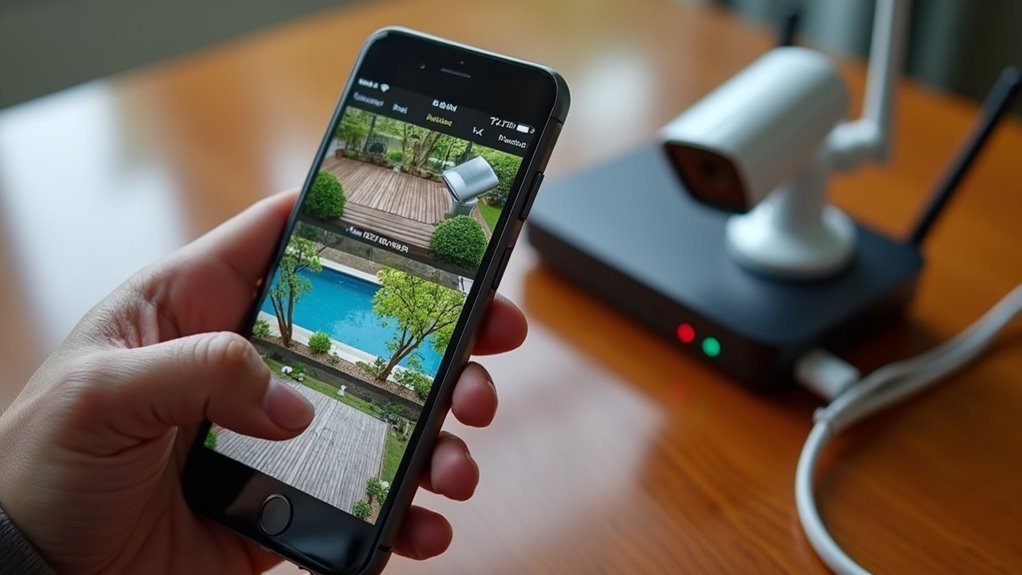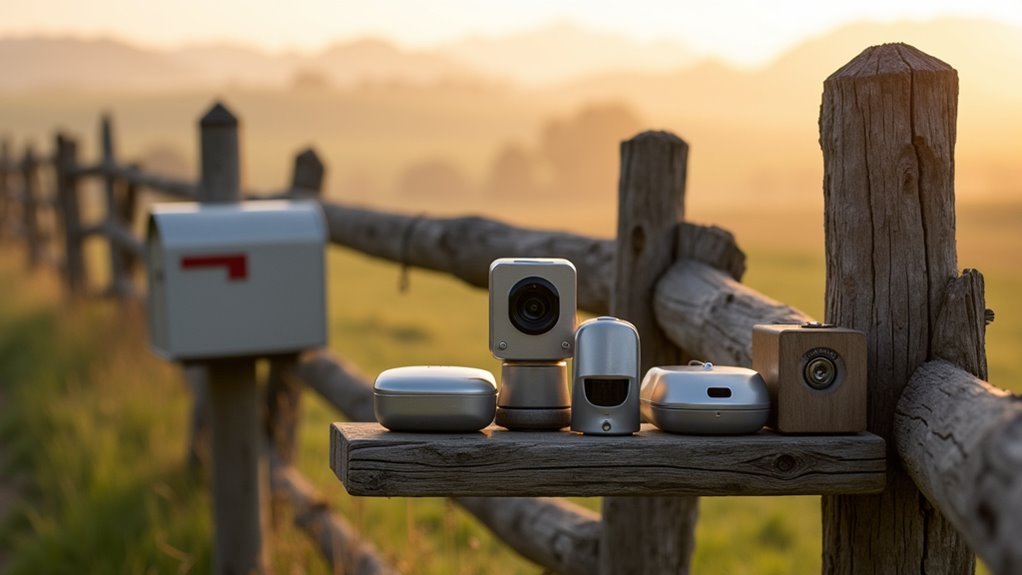You’ve probably noticed your energy bills creeping higher each month, but you’re not sure where all that power’s actually going. Most homeowners waste 20-30% of their energy on devices they don’t even realize are running, yet standard utility bills won’t tell you which appliances are the real culprits. The right energy monitoring dashboard can pinpoint these hidden energy drains and automatically optimize your usage, but choosing between whole-home monitors, smart plugs, and circuit-level systems isn’t straightforward.
Understanding Energy Monitoring Dashboard Fundamentals

While traditional utility bills only show your total monthly consumption, energy monitoring dashboards transform how you understand your home’s electricity usage by providing real-time, detailed insights into every aspect of your energy consumption.
These systems connect to whole-home monitors or individual appliance sensors, giving you thorough visibility into where your electricity goes.
Energy monitoring systems provide complete visibility into your home’s electricity usage through whole-home monitors and individual appliance sensors.
Most energy monitoring systems use machine learning to automatically identify appliances and their usage patterns.
You’ll see which devices consume the most power and when they’re operating. Real-time energy data helps you catch wasteful behaviors immediately rather than discovering them weeks later on your bill.
Advanced dashboards integrate with smart home technologies, enabling automated responses that reduce consumption without your constant attention, making energy management effortless and effective.
Whole-Home Energy Monitors Vs Individual Device Trackers
When choosing an energy monitoring system, you’ll face a fundamental decision between whole-home energy monitors that track your entire electrical panel and individual device trackers that focus on specific appliances or outlets.
Whole-home energy systems like the Sense Energy Monitor use machine learning to identify devices automatically and provide thorough electricity usage insights. Users typically achieve 10% average savings, with engaged users reaching 20% reductions.
Individual device trackers offer targeted benefits:
- Smart plug automation – Automatically cut power when devices aren’t in use
- Energy hog identification – Pinpoint specific appliances consuming excessive power
- Circuit-level monitoring – Track particular outlets or dedicated circuits
Both approaches help monitor energy usage effectively, though user engagement typically declines after three months.
As smart appliances evolve, they’ll likely incorporate built-in tracking capabilities.
Sense Energy Monitor Advanced Machine Learning Capabilities

The Sense Energy Monitor stands out among whole-home systems through its sophisticated machine learning technology that processes a million measurements per second to identify your appliances’ unique energy signatures.
This advanced energy monitoring system learns to recognize individual devices in your home, providing detailed insights into your energy consumption patterns.
You’ll typically see average savings of 10% on your energy bills after one year, with engaged users achieving up to 20% savings through behavioral changes.
The system integrates seamlessly with smart devices, allowing you to optimize usage scheduling for high-draw appliances.
Smart device integration enables automated scheduling optimization for energy-intensive appliances, maximizing efficiency and reducing peak-hour consumption costs.
However, about 15% of users experience initial device identification challenges, requiring patience as the machine learning algorithms adapt to your specific household’s energy patterns over time.
Emporia Vue 3 Budget-Friendly Circuit-Level Monitoring
You don’t need to break the bank to get detailed energy insights with the Emporia Vue 3, which delivers circuit-level monitoring at just $100.
You’ll track individual circuits in real-time and identify exactly which appliances drain the most power throughout your home.
The system’s smart scheduling features let you optimize high-draw devices while seamlessly integrating with your existing smart home setup.
Budget-Friendly Circuit Tracking
For just $100, Emporia’s Vue 3 delivers extensive circuit-level energy monitoring that puts detailed power consumption data at your fingertips.
This budget-friendly system transforms how you understand your home’s electricity consumption by providing real-time measurements for individual circuits rather than just whole-house totals.
The Vue 3 excels at detailed energy monitoring through three key capabilities:
- Real-time circuit tracking – Monitor specific circuits like HVAC, water heater, or kitchen outlets individually.
- Expandable sensor network – Add additional circuit-level sensors for thorough home coverage.
- Smart scheduling integration – Use the Emporia app to schedule high-draw devices during off-peak hours.
You’ll particularly benefit if you have time-of-use rates, as the Vue 3 helps identify when and where you’re consuming the most energy, enabling strategic usage shifts that reduce monthly bills.
Smart Integration Features
Beyond standalone energy tracking, Emporia Vue 3’s smart integration capabilities connect seamlessly with popular home automation platforms like Amazon Alexa, Google Assistant, and Samsung SmartThings.
You’ll receive real-time load measurements that trigger automated responses from your smart devices based on energy consumption thresholds you set. When high-draw circuits activate, you can program your system to automatically adjust thermostats, delay non-essential appliances, or send alerts to your phone.
The integration enables sophisticated energy savings through coordinated device management. You can schedule high-energy appliances to run during off-peak hours and create custom automation rules that respond to your household’s consumption patterns.
This interconnected approach transforms passive monitoring into an active energy management system that optimizes usage without sacrificing comfort.
Smart Plug Dashboard Integration Options

When you’re looking to gain granular control over your home’s energy consumption, smart plug dashboard integration transforms how you monitor and manage individual devices.
These sophisticated systems provide real-time data on energy consumption, enabling you to identify power-hungry appliances instantly.
Modern smart plugs like Kill-A-Watt and GreenSwitch offer thorough energy monitoring through mobile apps that track usage trends and send alerts for excessive consumption.
Your dashboard can deliver three key benefits:
- Predictive billing estimates based on historical usage patterns
- Automated scheduling during peak energy times for maximum savings
- Remote monitoring capabilities that enable proactive energy management
Advanced integration with smart home systems creates actionable insights into consumption patterns, helping you budget effectively while maintaining ideal control over your household’s energy usage.
Real-Time Energy Cost Tracking Features
While smart plugs provide device-level insights, real-time energy cost tracking features take your monitoring capabilities to the next level by translating consumption data into immediate financial impact. You’ll see exactly how much your energy consumption costs as it happens, helping you identify peak usage times and high-energy appliances instantly.
| Feature | Benefit |
|---|---|
| Instant cost display | View real-time spending as you use energy |
| Predictive bill estimates | Understand upcoming energy bills before they arrive |
| Custom spike alerts | Get notified when usage exceeds set thresholds |
These dashboards integrate with your local utility rates, revealing cost-saving opportunities you might otherwise miss. You can analyze consumption trends over time, pinpoint inefficiencies, and adjust usage patterns for maximum savings.
Mobile App Functionality and User Interface Design
Since your monitoring dashboard is only as effective as its interface, mobile app functionality and user interface design serve as the essential bridge between raw energy data and actionable insights.
Mobile apps for energy monitoring transform complex consumption data into digestible visual formats through intuitive dashboards and trend visualizations.
Effective user interface designs incorporate three critical elements:
- Real-time tracking displays that show immediate energy usage spikes and patterns
- Personalized recommendations based on your specific consumption habits to maximize energy efficiency
- Smart notifications that alert you during high-usage periods and suggest concrete reduction steps
The best mobile interfaces integrate seamlessly with smart devices, enabling automated energy-saving behaviors while maintaining user-friendly navigation that keeps you actively engaged with your consumption data.
Solar System Compatible Dashboard Solutions
As solar adoption accelerates across residential markets, solar system compatible dashboard solutions have become essential tools that merge energy production and consumption data into unified monitoring platforms.
You’ll find systems like Sense Energy Monitor and Emporia Energy Vue seamlessly integrate with your solar panels, delivering extensive real-time tracking of both generation and consumption metrics.
These dashboards transform your energy monitoring experience through mobile apps that send alerts about solar performance and electricity usage patterns. You can access predictive analytics that forecast your energy bills based on current solar output and historical consumption data, making budgeting more accurate.
As smart home technology advances, future dashboards will automate energy management, optimizing your usage and maximizing savings while providing deeper solar performance insights.
DIY Installation Requirements and Safety Considerations
Though energy monitoring systems offer compelling benefits, installing them yourself presents significant electrical hazards that require careful consideration before you begin.
DIY installation poses serious shock risks, especially when connecting sensors to your electrical panel’s service mains. Without proper expertise, you’re gambling with both safety and accuracy.
Here are three critical safety considerations:
- Professional expertise guarantees code compliance – Local electrical codes vary, and violations can create liability issues.
- Secure sensor attachment requires specialized knowledge – Improper installation leads to inaccurate readings and wasted investment.
- Complex wiring demands experience – Even “DIY-friendly” systems often need professional configuration for peak functionality.
While professional assistance increases upfront costs, it’s a worthwhile investment that assures safe installation and reliable energy monitoring data.
Data Visualization and Analytics Tools
Once your energy monitoring system is professionally installed and operational, the real value emerges through sophisticated data visualization and analytics tools that transform raw electrical data into actionable insights.
These dashboards present real-time energy consumption trends through advanced charts and graphs, helping you spot usage spikes and inefficiencies instantly.
You’ll access predictive analytics that estimate upcoming bills, enabling smarter decisions about your energy habits.
Key metrics include cost analysis, carbon emissions tracking, and energy intensity assessments for thorough environmental impact awareness.
Most systems offer customizable alerts and mobile app integration, keeping you connected to your consumption patterns remotely.
This data visualization empowers proactive energy monitoring and meaningful conservation efforts.
Smart Home Integration and Automation Features
While data visualization provides critical insights into your energy consumption patterns, the true power of modern energy monitoring systems emerges when they integrate seamlessly with your smart home ecosystem.
Energy monitors can automatically reduce your consumption by up to 16% through intelligent automation features that work without your intervention.
Modern systems like the Sense Energy Monitor use machine learning to identify your appliances’ unique energy signatures, enabling sophisticated automation:
- Smart scheduling – automatically runs high-draw devices during off-peak hours
- Thermostat coordination – adjusts heating and cooling based on real-time data
- Load balancing – prevents energy spikes by managing multiple smart appliances simultaneously
These automation features transform your energy monitor from a passive reporting tool into an active energy management system.
Professional Vs Consumer-Grade Monitoring Systems
How do you determine whether a consumer-grade energy monitor will meet your needs, or if you should invest in a professional-grade system? The choice depends on your application scale, accuracy requirements, and budget.
| Feature | Consumer-Grade | Professional-Grade |
|---|---|---|
| Installation | DIY-friendly | Requires certified electricians |
| Cost | $100+ | $1,000+ |
| Accuracy | Basic tracking with machine learning | Revenue-grade precision |
| Integration | Smartphone apps | Building management systems |
Consumer-grade energy monitoring systems like Sense utilize machine learning for appliance identification, though accuracy varies. They’re perfect for residential users seeking basic consumption insights. Professional-grade systems deliver thorough data analysis and integrate with building management systems, making them essential for commercial applications requiring precise energy management and detailed reporting capabilities.
Long-Term Energy Savings Tracking Methods
You’ll need robust tracking methods to measure your energy monitor’s long-term impact on consumption and costs.
Annual consumption pattern analysis helps you identify seasonal trends and year-over-year improvements, while dedicated cost reduction measurement tools quantify your actual dollar savings over time.
Behavioral change impact assessments let you evaluate which habit modifications produce the greatest energy reductions, ensuring you maintain momentum beyond the typical three-month engagement period.
Annual Consumption Pattern Analysis
Once you’ve gathered several months of energy data, annual consumption pattern analysis becomes your most powerful tool for identifying long-term savings opportunities.
This thorough review reveals seasonal trends, behavioral patterns, and equipment inefficiencies that monthly snapshots can’t capture.
Your energy monitors enable precise tracking that supports effective energy management through:
- Peak usage identification – You’ll spot when your consumption spikes during specific seasons or times, allowing targeted behavioral adjustments.
- Phantom load detection – You can identify devices silently draining energy year-round, often accounting for 5-10% of total usage.
- Appliance efficiency trends – You’ll notice when equipment performance degrades over time.
Studies show engaged users achieve 10-20% annual savings through targeted changes.
You’ll maximize these savings by analyzing yearly patterns and implementing predictive strategies for upcoming billing periods.
Cost Reduction Measurement Tools
While annual consumption patterns reveal where energy goes, measuring actual cost reductions requires dedicated tracking tools that quantify your savings over extended periods.
Energy monitoring systems like the Emporia Vue Gen 3 excel at cost reduction tracking through circuit-specific measurements, letting you see exactly which changes impact your bills. Real-time measurements help you correlate behavioral modifications with immediate savings, while long-term data reveals cumulative benefits.
You’ll achieve the best results by maintaining consistent engagement beyond the typical three-month drop-off period. Continuous users often double their savings compared to casual monitors.
Smart technologies integrated with your energy monitoring dashboard automate tracking processes, delivering up to 16% reduction in usage while minimizing manual intervention requirements for sustained cost reduction success.
Behavioral Change Impact Assessment
Beyond tracking immediate cost reductions, understanding how your energy habits evolve over time reveals the true power of monitoring systems.
Energy monitors enable informed decision-making that transforms your relationship with electricity consumption, delivering measurable behavioral changes that compound over time.
Your energy savings potential follows predictable patterns:
- Initial gains – You’ll typically see 7-10% reductions in your first year through basic habit adjustments.
- Engagement peaks – Maximum behavioral changes occur within the first three months of active monitoring.
- Long-term mastery – Sustained engagement with push notifications and data analysis can facilitate up to 20% savings through permanent lifestyle shifts.
The key lies in maintaining consistent interaction with your dashboard.
Users who actively unplug devices, manage phantom loads, and upgrade to smart appliances achieve the most significant reductions.
Dashboard Customization and Personalization Options
How can you transform a generic energy monitoring interface into a powerful, personalized command center?
Dashboard customization lets you prioritize specific metrics like real-time consumption, historical trends, or cost estimates, dramatically boosting user engagement with your energy data.
Customized dashboards transform raw energy data into actionable insights, turning passive monitoring into active engagement with your consumption patterns.
You’ll find categorization features invaluable for organizing appliances and circuits by device or room, making it easier to spot inefficiencies in your energy usage patterns.
Personalized alert settings guarantee you’re notified when consumption spikes or crosses predetermined thresholds, enabling immediate action.
Integration capabilities connect your monitoring system with other smart home devices, creating a centralized optimization platform.
Most importantly, user-friendly mobile apps provide on-the-go customization, letting you adjust settings and monitor energy usage anywhere, supporting truly proactive energy management.
Frequently Asked Questions
What Is the Best Way to Monitor Energy Usage?
You’ll get best results using whole-home energy monitors like Sense ($229) or Emporia Vue ($100). Stay engaged with the data beyond three months and combine with smart thermostats for maximum 16% savings.
What Are the Different Types of Energy Monitoring?
You’ll find two main types of energy monitoring: whole-home systems that connect to your electrical panel for thorough tracking, and individual appliance monitors like smart plugs that measure specific devices.
Can I Get a Free Energy Monitor?
You can often get free energy monitors through your utility company’s efficiency programs, local government initiatives, or non-profit organizations. Check with your utility provider first, as many offer subsidized devices to customers.
Are Home Energy Monitors Worth It?
You’ll likely save 7-10% on electricity bills, potentially up to 20% if you’re engaged. At $100-229, monitors pay for themselves within 1-2 years through reduced energy costs and improved efficiency.





Leave a Reply